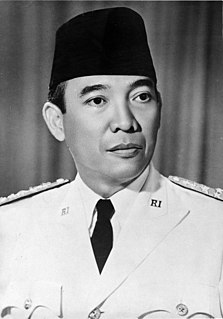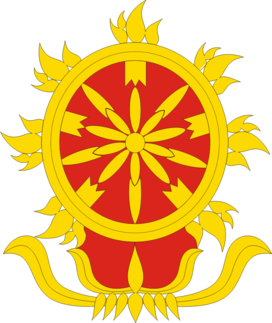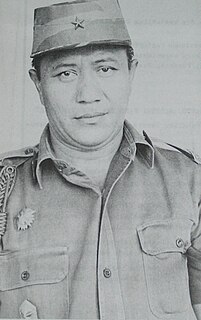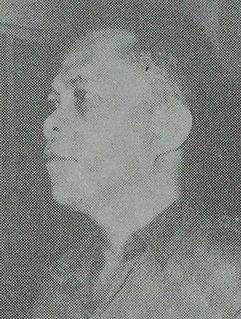This article includes a list of references, but its sources remain unclear because it has insufficient inline citations .(November 2017) (Learn how and when to remove this template message) |

Supardjo was a Brigadier General in the Indonesian Army. He was one of the leaders of the 30 September Movement, a group that killed six of the army's top generals and launched a failed coup attempt on 30 September 1965.
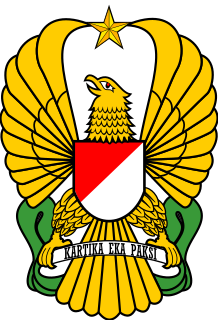
The Indonesian Army, the land component of the Indonesian National Armed Forces, has an estimated strength of 300,000 active personnel. The history of the Indonesian Army has its roots in 1945 when the Tentara Keamanan Rakyat (TKR) "Civil Security Forces" first emerged as a paramilitary and police corps.
The Thirtieth of September Movement was a self-proclaimed organization of Indonesian National Armed Forces members who, in the early hours of 1 October 1965, assassinated six Indonesian Army generals in an abortive coup d'état. Later that morning, the organisation declared that it was in control of media and communication outlets and had taken President Sukarno under its protection. By the end of the day, the coup attempt had failed in Jakarta at least. Meanwhile, in central Java there was an attempt to take control over an army division and several cities. By the time this rebellion was put down, two more senior officers were dead.
Contents
Supardjo was regimental commander of the Siliwangi Division which was stationed in West Java. As a result of his pro-Communist sympathies and actions, he was sent to Kalimantan, away from the centres of power on Java, and took part in the Indonesian actions against British and Malaysian troops in Borneo (see Konfrontasi ). Based at Menggaian in West Kalimantan, he led the Fourth Combat Command of KOSTRAD, the army's strategic reserve.

West Java is a province of Indonesia. It is located in the western part of the island of Java and its capital and largest urban center is Bandung, although much of its population in the northwest corner of the province live in areas suburban to the larger urban area of Jakarta, though that city itself lies outside the administrative province. With a population of 46.3 million West Java is the most populous of Indonesia's provinces.
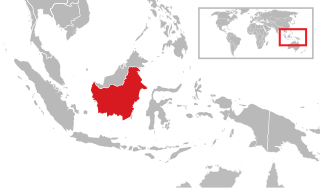
Kalimantan is the Indonesian portion of the island of Borneo. It comprises 73% of the island's area. The non-Indonesian parts of Borneo are Brunei and East Malaysia. In Indonesia, "Kalimantan" refers to the whole island of Borneo.

Java is an island of Indonesia, bordered by the Indian Ocean on the south and the Java Sea on the north. With a population of over 141 million or 145 million, Java is the home to 56.7 percent of the Indonesian population and is the world's most populous island. The Indonesian capital city, Jakarta, is located on its northwestern coast. Much of Indonesian history took place on Java. It was the center of powerful Hindu-Buddhist empires, the Islamic sultanates, and the core of the colonial Dutch East Indies. Java was also the center of the Indonesian struggle for independence during the 1930s and 1940s. Java dominates Indonesia politically, economically and culturally. Four of Indonesia's eight UNESCO world heritage sites are located in Java: Ujung Kulon National Park, Borobudur Temple, Prambanan Temple, and Sangiran Early Man Site.
On 28 September 1965, he left his post without the knowledge of then KOSTRAD commander, Suharto (later President of Indonesia). He had received a telegram from his wife stating that his child was sick. At Supardjo's trial in 1967, an ex-Communist official testified that the cable was code between Supardjo and Communist participating in the coup, and that the real reason for his return to Java was to help command the coup.

Suharto was an Indonesian military leader and politician who served as the second President of Indonesia, holding the office for 31 years, from the ousting of Sukarno in 1967 until his resignation in 1998. He was widely regarded by foreign commentators as a dictator. However, his legacy is still debated at home and abroad.

The President of the Republic of Indonesia is the head of state and also head of government of the Republic of Indonesia. The president leads the executive branch of the Indonesian government and is the commander-in-chief of the Indonesian National Armed Forces.
Some Supardjo's military colleagues reported he was resentful over his slow pace of promotion and may have had a grudge against army commander, General Yani, who was one of the 30 September Movement's principal victims. According to General Sarwo Edhie Wibowo, commander of the fiercely anti-communist RPKAD para-commandos, Supardjo requested RPKAD reinforcements be sent to Kalimantan on 1 October. When Sarwo Edhie heard of the coup attempt, the sailing orders to Kalimantan were cancelled.

Sarwo Edhie Wibowo was an Indonesian military leader and the father of Kristiani Herrawati, the former first lady of Indonesia and the wife of president Susilo Bambang Yudhoyono, and also the father of Chief of Staff Pramono Edhie Wibowo. As an army colonel he played a role in directing troops during the Indonesian killings of 1965–66, in which more than a million Indonesian civilians died. Later, he served as Chairman of the BP-7 center, as Indonesia's ambassador for South Korea and as governor of the Indonesian Military academy.
